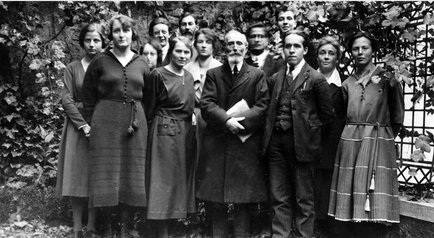Art Fills Photography’s Gaps: What To Do When There are No Photos of Sabina Spielrein
We live with photographs always at hand. All our media sources are filled with peoples’ pictures, friends and family are constantly sending us pictures of themselves, we have selfies; and, of course, there are Facebook and Instagram images showing us how so many of us look, in so many places, at so many times. It is distressing now when we can’t find an image of another person.
This is a blog about a woman with an exceptionally sparse photographic record and a story of how I tried to make up for that lack by creating an image of her through the art of her time and my own. First, I will write something about who the woman was and then I will share images of paintings and prints that I think show us something about her. The artists who helped me fill out the picture are Felix Vallotton, Ernst Kirchner, and Eri Iwasaki.
Sabina Spielrein was an early psychoanalyst. She worked in Austria, Germany, Switzerland, and Russia from the early part of the 20th century until her death in 1942 in the Nazis’ massacre of Jews in the Russian town of Rostov. She made pioneering contributions to child analysis and development; and the understanding of critical ideas such as the relevance of evolutionary theory to psychology, and the link between the death instinct and the sex instinct. She was an extensively published scholar, a teacher and lecturer, and a clinician and analyst. She was a member of the Vienna Psychoanalytic Society and the analytic associations in Switzerland and Russia. She had important ties with key figures in the field, including Freud, Bleuler, Piaget, and Vygotsky. Still a teenager, she was briefly a patient at the Burgholzli Clinic where she was treated by Carl Jung. She quickly went on to become Jung’s research assistant and student, collaborator, and close friend.
In spite of the breadth of her connections and key role in the creation of a scholarly respectable psychoanalysis, Sabina Spielrein and her work were virtually forgotten from the time of her death until the late 1970s. All the scholarly and clinical work she had done appeared to have been erased. Thankfully, that changed in the late 70s with the discovery in Geneva of her personal papers including a diary and letters. Since then, scholars have begun paying attention to her work and writing seriously about it. The popular media has also taken notice. Unfortunately, too much popular attention has put the spotlight on her relationship with Carl Jung and questions about the whether theirs was a sexual connection and the extent to which it set up a triangle involving Sabina, Jung, and Freud. Her work, again, appears to be at risk of being overlooked.
In wanting to know more about Sabina and how she moved through her very complicated times and places, I wanted to know what she looked like. Unfortunately, I could find only two photographs of Sabina as an adult. Both were very fuzzy images, one from her identity papers (1931) and the other, a group shot of the men and women staff of the Institut Jean-Jacques Rousseau (1921).
Sabina is in front row, second from left.
That is it. One cannot explain the gap with the claim that there were not so many photographs then. There are certainly many photographs of Freud and Jung and their male and female associates. In fact, two other prominent women in these circles, Lou Andreas-Salome and Toni Wolff, are frequently and stunningly captured by the camera. Take care: If you google for an image of Sabina, you are likely to get Lou and Toni.
Art images on the way. Please revisit this blog.

